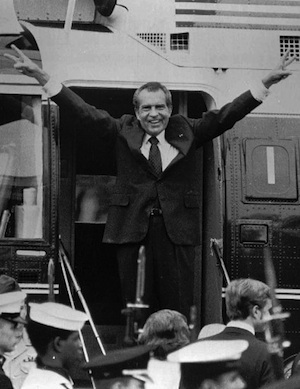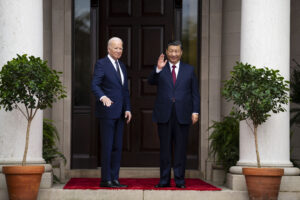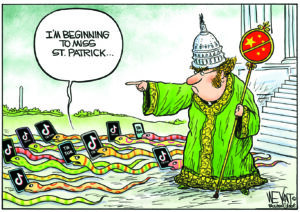Richard Nixon at 100: The Man Who Matters
Richard Nixon, who would have turned 100 on Wednesday, endures as the commanding figure of American political life since the end of World War II His style, achievements and failures persist nearly two decades after his death.
Richard Nixon, who would have turned 100 on Wednesday, endures as the commanding figure of American political life since the end of World War II. His style, achievements and failures persist nearly two decades after his death. He is the most impressive political figure of the past 60 years, and his influence has extended beyond his times. But influence can cut in several ways.
Almost 40 years since the dramatic end of Nixon’s presidency, his doings have consequences and opinions of him continue to divide us. We have loyalists and admirers determined to burnish his life and career, and we have those who dismiss him — “enemies,” as Nixon characterized them — simply as an opportunist, with little substance. Both camps can readily compile a history to make their point, but we cannot deny the fact that then and now, Nixon matters.
Nixon’s life and career were marked by ongoing fights and battles (to use his signature metaphors) for his political successes and his reputation. He obsessed over his history, yet his history is problematic for it may not have been one he desired, nor was it always pretty.
Nixon swept across the political landscape from his first campaign in 1946 against a prominent New Deal congressman, during which he honed the style of redbaiting; to his 1950 senatorial campaign in which he refined it to an art form and gained an enduring epitaph — “Tricky Dick”; to his selection as presidential candidate Dwight Eisenhower’s running mate in 1952 and the controversy over his political funds, which he deftly turned to his advantage in the “Checkers” speech that inaugurated a new age of political television; to his years as vice president when he stirred conflict and controversy galore; to the campaign of 1960, with its televised debates, and then the excruciating agony of his narrow defeat that year; to his presidency that provided spectacular additions and exercises of power, giving new impetus to the rise of the “Imperial Presidency”; to the riveting scandal of Watergate, resulting in an unprecedented presidential resignation; and finally to his winter years, with the Forever Campaigner engaged in a relentless battle for vindication.
Leaders leave legacies, and so we measure and define our presidents. Think of the broad array of Nixon’s accomplishments and influences, and consider their unintended consequences.
President Eisenhower, elected after two decades of Democratic governance, made it clear to his own party that it was foolish to attempt any overturn of the prevailing consensus. Nixon agreed and led the Republicans to activist, interventionist initiatives in a variety of areas, including environmental legislation and programs; expanded government regulation of the economy; Title X — the primary federal family planning program that includes money for breast cancer screenings as well as treatment for sexually transmitted diseases; and Title IX, which prohibits sex discrimination in federally financed education programs and has benefited nearly 3.5 million female athletes, more than 10 times the number there was in 1971. Nixon’s influence, however direct or indirect, has survived with these programs. Yet the irony is that almost all of them are vehemently denounced today by GOP candidates, especially on the national level. When the Supreme Court decided Roe v. Wade with support from his own nominees, Nixon reacted with typical ambivalence, questioning the decision. But he believed an abortion might be necessary after a rape — or as he privately said, if you have “a black and a white [person].”
The president’s admirers usually begin their list of Nixon’s accomplishments with foreign policy, such as détente with the Soviet Union. Nixon held his ground against his own right-wing allies in the Republican Party, people with whom he tirelessly had denounced Communism. But the centerpiece of his achievements must be his audacious opening to China, the same “Red China” he had so consistently scorned. The recognition of China was justified to Nixon’s conservative faction as playing the “China Card” to counter the influence of the Soviet Union. Now we have the ironic outcome of China as our primary economic and military competitor, while Russian influence has waned.
The realignment of American electoral politics certainly is one of Nixon’s most enduring feats. His presidency witnessed the formalization of the old Republican-Dixiecrat — read segregationists — conservative congressional alliance that originated in the late 1930s. The civil rights revolution of the 1960s reversed the historic Democratic hold on the “Solid South,” with Democrats becoming Republicans, and created a new “Solid South” with Republicans expanding their power in Congress.
Nixon’s “Southern Strategy” in his 1968 election run carefully pursued Southern votes, quietly promising an easing of desegregation policies. The notorious segregationist Sen. J. Strom Thurmond of South Carolina served as Nixon’s liaison to other Southern politicians, and he had figured most prominently in fracturing the national Democratic Party over the race issue. Nixon’s administration amassed quite an admirable record on race relations — and one that did not leave Nixon ambivalent.
Nixon politicized the role of the Supreme Court in his 1968 campaign as no presidential candidate had before him. Even Franklin D. Roosevelt in 1936 did not use the court as an electoral issue as Nixon did, although reactionary, black-robed judges offered the most serious obstacle to his New Deal reforms. Nixon consistently assailed Chief Justice Earl Warren’s court for its alleged softness on criminal rights and promised a restoration of “law and order,” obvious code language for reversing civil rights achievements. He advocated “strict construction,” a term widely misused and misunderstood but now part of current debates over the qualifications of Supreme Court nominees. Six years earlier, when the justices struck down the New York Regents’ compulsory prayer, Nixon had readily denounced the court for its “strict construction” of the establishment clause.
Shortly after his 1968 victory, Nixon appointed Warren Earl Burger as chief justice, a jurist noted for public criticism of his fellow appellate judges and Warren court decisions. He then nominated two deeply flawed Southern judges, obvious payoffs to Thurmond, but the Senate decisively rejected both. Nixon filled one seat with Assistant Attorney General William Rehnquist, whom he did not know — “Renchburg,” he called him — but he cheered when he learned more of Rehnquist’s conservative political ideology. Rehnquist’s other important qualification for Nixon was his relative youthfulness, and the president correctly forecast a “Nixon influence,” one that ultimately has prevailed on the court for 30 or more years. When Nixon finally met Rehnquist (in those days after the nomination had been made), he used the occasion for a typical Nixonian “pep talk.” “I will give you one last bit of advice, because you’re going to be independent, naturally,” the president said. “And that is don’t let the fact that you’re under heat change any of your views. … So just be as mean and rough as they said you are.” Perhaps another accurate prediction. “Thanks, Mr. President,” an obviously pleased Rehnquist replied as the conversation ended.
Rehnquist began his Supreme Court tenure dissenting on a wide variety of cases, including the brand new issue of abortion. He argued that the 14th Amendment was designed to deal with slavery, and he narrowly restricted its application in current issues. His views on criminal procedure, the establishment clause, the commerce clause and federalism consistently rejected precedents of earlier years. By the time he became chief justice in 1986, Rehnquist clearly had emerged as the intellectual and ideological leader of the court. Subsequent appointments were largely in his own image, such as his successor, John Roberts, Rehnquist’s ideological companion and former clerk. Nixon’s forecast has proven all too true.
And then we have Watergate, Nixon’s “spot that will not out” and one that must be confronted in consideration of his legacy. Nixon early on realized the dangers posed by his men who conceived and approved the break-in of Democratic headquarters in June 1972. On the night of his re-election in November 1972 Nixon felt a “foreboding” that dampened his enthusiasm. Watergate, he wrote in his diary, was the only “sour note” of the moment. “Stupidity,” he wrote, on the part of people involved; yet he knew his own liabilities resulting from his direction and participation in the cover-up.
As Watergate unraveled, Nixon’s role came into stark relief; the eventual access to some 30 hours of Oval Office tapes revealed how Nixon launched the cover-up on the day after the break-in when he and his chief of staff concocted the idea of using the CIA to divert the FBI’s entry into the case. Several months of Senate hearings, investigations by U.S. attorneys and their successor special prosecutors, and a probing, hard-line judge compiled an array of evidence implicating the president. The House Judiciary Committee conducted an impeachment inquiry that resulted in several charges that Nixon had engaged in “abuses of power” and a criminal obstruction of justice. Meanwhile, the Supreme Court the day before had ruled that Nixon had no claim to “executive privilege” to withhold tapes that might offer evidence of his criminal involvement. After the new tapes were released, Nixon chose to resign, rather than face impeachment. The man who liked to claim many firsts, was the first to give meaning to an otherwise obscure constitutional clause.
Nixon’s unprecedented departure has had ongoing significance. Watergate spawned the politics of payback and scandal that have marked the past 40 years. Certainly it has burdened every president confronted with questions involving the suffix “gate,” “gotcha” journalism, “what did the president know and when did he know it” and other Watergate clichés. But singularly for Nixon, we remember his disgrace without honor. In one of his periodic attempts to “return,” Nixon said that “when the president does it, that means that it is not illegal.” What in the world could he have been thinking?
After his resignation, Nixon poured his energies into his final campaign — the battle for history. Alexander Butterfield, the man who revealed the existence of the White House taping system — which, of course, was Nixon’s undoing — described the president as a man always conscious of his history. “[T]he president is very history oriented and history conscious about the role he is going to play,” Butterfield testified to the Senate Watergate Committee in July 1973, and added that Nixon “is not at all subtle about it, or about admitting it.”
History very much mattered to Nixon. No different from other leaders who realized that when their power faded, they had only their history, which they desperately tried to control. Nixon installed the White House taping system in a vain belief that he would capture the authoritative version of his presidency. Ironically, those tapes sealed his downfall, and to this day they continue to diminish the man and his achievements.
Nixon offered the paradox of an intelligent yet curiously flawed man who left a divided legacy, often resulting from his self-destructive actions. His lament over Watergate (“I gave them a sword and they stuck it in,” he told journalist David Frost. “And they twisted it with relish. And, I guess, if I’d been in their position I’d have done the same thing”) however self-pitying, underlines the fundamental truth that he was his own worst enemy. He was a man of great power who left a stamp on his time and beyond, yet petty enough to accomplish his own ruin.
Speaking at his East Room “farewell” just before resigning, Nixon offered the most prescient judgment of himself: “Always remember, others may hate you, but those who hate you don’t win unless you hate them — and then you destroy yourself.”
Your support matters…Independent journalism is under threat and overshadowed by heavily funded mainstream media.
You can help level the playing field. Become a member.
Your tax-deductible contribution keeps us digging beneath the headlines to give you thought-provoking, investigative reporting and analysis that unearths what's really happening- without compromise.
Give today to support our courageous, independent journalists.






You need to be a supporter to comment.
There are currently no responses to this article.
Be the first to respond.